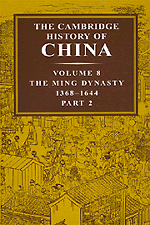Book contents
- Frontmatter
- Introduction
- 1 Ming government
- 2 The Ming fiscal administration
- 3 Ming law
- 4 The Ming and Inner Asia
- 5 Sino-Korean tributary relations under the Ming
- 6 Ming foreign relations: Southeast Asia
- 7 Relations with maritime Europeans, 1514–1662
- 8 Ming China and the emerging world economy, c. 1470–1650
- 9 The socio-economic development of rural China during the Ming
- 10 Communications and commerce
- 11 Confucian learning in late Ming thought
- 12 Learning from Heaven: the introduction of Christianity and other Western ideas into late Ming China
- 13 Official religion in the Ming
- 14 Ming Buddhism
- 15 Taoism in Ming culture
- Bibliographic notes
- Bibliography
- Glossary-Index
- References
2 - The Ming fiscal administration
Published online by Cambridge University Press: 28 March 2008
- Frontmatter
- Introduction
- 1 Ming government
- 2 The Ming fiscal administration
- 3 Ming law
- 4 The Ming and Inner Asia
- 5 Sino-Korean tributary relations under the Ming
- 6 Ming foreign relations: Southeast Asia
- 7 Relations with maritime Europeans, 1514–1662
- 8 Ming China and the emerging world economy, c. 1470–1650
- 9 The socio-economic development of rural China during the Ming
- 10 Communications and commerce
- 11 Confucian learning in late Ming thought
- 12 Learning from Heaven: the introduction of Christianity and other Western ideas into late Ming China
- 13 Official religion in the Ming
- 14 Ming Buddhism
- 15 Taoism in Ming culture
- Bibliographic notes
- Bibliography
- Glossary-Index
- References
Summary
INTRODUCTION
Many characteristic features of Ming fiscal administration trace their origins to the first Ming emperor's peculiar concept of government. In 1380, the office of the prime minister was abolished, never to be revived. Henceforth, the emperor acted as his own chief executive officer. After a series of bloody purges that lasted from 1376 to 1396, the bureaucracy was virtually reduced to a huge clerical pool, subservient to the sovereign but not empowered to make important decisions. The new system that the first emperor had created called for an omnipresent ruler who exercised personal control over a population officially reported at close to sixty million. The civil government functioned as not much more than a transmitter of imperial wishes.
The situation at the local level was the reverse of the situation at the top of the administrative hierarchy. Villages were organized into self-governing communities. The basis for these group associations was not civil law, but Confucian morality. With intra-community litigations settled by imperial adjudication and unruly persons punished by their own elders, local communities needed little official supervision. In fact, the first Ming emperor even refused to allow his governmental functionaries to enter rural areas. This organizational scheme reveals a curious amalgam of arbitrary, autocratic rules and idealistic notions. Such an administrative system was basically unsound. The success of its operation relied more on the ideological cohesion and administrative discipline that bound the governing as well as the governed than on official administrative procedures. The first Ming emperor, in fact, ran his administration by cowing his subjects with brutal and arbitrary punishments on the one hand and moral exhortations on the other.
- Type
- Chapter
- Information
- The Cambridge History of China , pp. 106 - 171Publisher: Cambridge University PressPrint publication year: 1998
References
- 8
- Cited by

